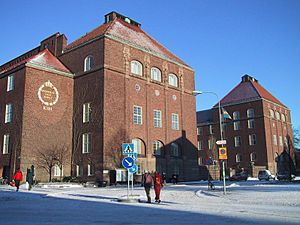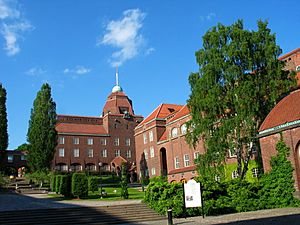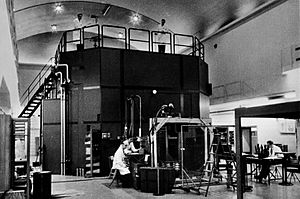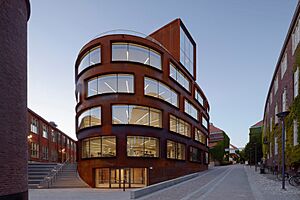KTH Royal Institute of Technology facts for kids
|
Kungliga Tekniska högskolan
|
|
 |
|
| Motto | Vetenskap och konst |
|---|---|
|
Motto in English
|
Science and Art |
| Type | Public Research University |
| Established | 1827 |
| Budget | SEK 5.484 billion |
| Chairman | Ulf Ewaldsson |
| President | Anders Söderholm |
|
Academic staff
|
1,539 (2023) |
|
Administrative staff
|
1,160 (2023) |
| Students | 13,955 (2023) |
| 1,035 (2023) | |
| Location | , |
| Campus | Urban |
| Colors | Blue |
| Affiliations | CLUSTER, CESAER, EUA, T.I.M.E. association, PEGASUS, NORDTEK, Nordic Five Tech, UNITE! |
The KTH Royal Institute of Technology, usually just called KTH, is a large public university in Stockholm, Sweden. It is a place where students learn about engineering and technology. KTH is the biggest technical university in Sweden. It has five schools and four campuses located in and around Stockholm.
KTH was founded in 1827 as the "Institute of Technology" (Teknologiska institutet). It grew out of an even older school called the "School of Mechanics" (Mekaniska skolan), which started in 1798. The school's history goes all the way back to 1697, when a scientist named Christopher Polhem started a workshop to teach mechanics.
In 1877, the school got its current name, Kungliga Tekniska högskolan, which means KTH Royal Institute of Technology. The King of Sweden, Carl XVI Gustaf, is the official protector of the university.
KTH is known as one of the best universities in the world. In the 2024 QS World University Rankings, it was ranked 73rd out of all universities globally.
Contents
History of KTH
From Workshop to University
KTH's story began in 1697 with a workshop called the Laboratorium Mechanicum. It was started by Christopher Polhem, a famous Swedish scientist who is often called the "father of mechanics" in Sweden. He created it as a place to teach engineering using mechanical models.
This workshop later became the School of Mechanics in 1798. In 1827, it was turned into the Technological Institute. At first, it had only two professors, one for chemistry and one for physics. The school taught skills that were more like crafts than modern engineering.
In the 1840s, the school was reorganized to become a proper engineering college. Students had to pass an entrance test and be at least 16 years old. The programs were also made longer, from two years to three.
Growing and Getting a New Name
In the 1870s, the school grew even more. It merged with the School of Mining and took over a civil engineering course. In 1877, it was given its current name: KTH Royal Institute of Technology. This new name showed that it was now a high-level college, not just an institute. It also began teaching architecture.
In 1917, KTH moved to a new campus with beautiful buildings that are still used today. A decade later, in 1927, KTH was given the right to award doctorates, the highest degree a student can earn. This meant it was a true research university.
Today, KTH is responsible for about one-third of all engineering education and research in Sweden. It has thousands of students and staff members.
The Secret Nuclear Reactor
After World War II, Sweden wanted to learn about nuclear power. So, scientists at KTH were given a mission to research neutrons, which are tiny particles inside atoms. They decided to build a nuclear reactor to do their experiments.
They built the reactor, called R1, in a hall 25 meters underground, right beneath the KTH campus in the middle of Stockholm. At the time, about 40,000 people lived within a kilometer of the site. It was a risky project, but it was seen as very important for science.
On July 13, 1954, the reactor was turned on, creating Sweden's first nuclear reaction. The R1 reactor was used for almost all of Sweden's nuclear research until 1970. It was shut down because people became more aware of the dangers of having a reactor in a busy city.
What Does the Motto Mean?
KTH's motto is "Vetenskap och konst," which translates to "Science and Art."
The word "konst" (art) here doesn't just mean painting or sculpture. It refers to the "art" of using science to create things. This is what engineering is all about. So, a better way to understand the motto is "Science and the Art of Applying It."
Schools at KTH
KTH is divided into five main schools. Each school focuses on different areas of study and research.
- School of Architecture and the Built Environment
- School of Electrical Engineering and Computer Science
- School of Engineering Sciences
- School of Engineering Sciences in Chemistry, Biotechnology and Health
- School of Industrial Engineering and Management
How KTH Ranks Globally
Universities around the world are often ranked to see how they compare. KTH consistently ranks among the best, especially in engineering and technology.
Overall Rankings
- In 2025, the QS World University Rankings placed KTH at 74th in the world.
- In 2025, the Times Higher Education (THE) World University Rankings placed it at 95th.
Subject Rankings
KTH is especially strong in certain subjects. Here are some of its top-100 world rankings from QS in 2023:
- Mechanical Engineering: 23rd
- Electrical and Electronic Engineering: 23rd
- Materials Science: 23rd
- Architecture: 26th
- Civil and Structural Engineering: 44th
- Mathematics: 48th
- Computer Science: 62nd
KTH Campuses
KTH has several campuses, each with its own special focus.
KTH Main Campus
The main campus is in a Stockholm neighborhood called Östermalm. Its oldest buildings were finished in 1917 and were designed by the architect Erik Lallerstedt. The campus is decorated with sculptures and art by famous Swedish artists.
KTH Kista
The Kista campus is north of the city center. This area is known as Sweden's "Silicon Valley" because it has over a thousand technology companies, like Ericsson and Microsoft. The KTH school for computer science and electrical engineering is located here.
KTH Flemingsberg
The Flemingsberg campus is a major center for biotechnology. The KTH school for chemistry and health sciences is here. It works closely with other universities and companies in the area.
KTH Södertälje
This is the smallest KTH campus. It works with big companies like Scania (a truck maker) and AstraZeneca (a medicine company). Students here focus on mechanical engineering and product development.
The KTH Library
The KTH Library is the largest technology and science library in Sweden. It started in 1827 with just 800 books. Today, it has a huge collection of printed books and focuses on providing digital books and journals.
The main library building is a famous landmark on the main campus. It was designed in 1917 and has been beautifully renovated. The building has won several awards for its architecture.
Famous People from KTH
Many successful and famous people have studied or taught at KTH.
Famous Graduates
- Daniel Ek: Co-founder of the music streaming service Spotify.
- Christer Fuglesang: The first Swedish astronaut to go to space.
- Dolph Lundgren: A famous actor who has appeared in many action movies.
- Gustaf Larson: One of the co-founders of the car company Volvo.
- Ivar Kreuger: A famous industrialist who built a global business empire.
- Max Tegmark: A professor and cosmologist at the Massachusetts Institute of Technology (MIT).
Famous Teachers
- Hannes Alfvén: A scientist who won the Nobel Prize in Physics in 1970.
- Lennart Carleson: A mathematician who won the prestigious Abel Prize.
- Kai Siegbahn: A physicist who also won the Nobel Prize in Physics, in 1981.
- Stanislav Smirnov: A mathematician who won the Fields Medal, one of the highest honors in mathematics.
See also
 In Spanish: Real Instituto de Tecnología para niños
In Spanish: Real Instituto de Tecnología para niños
- List of universities in Sweden
- Top Industrial Managers for Europe
Images for kids
-
A statue of Kerberos, the three-headed dog from Greek mythology, guards an entrance.








